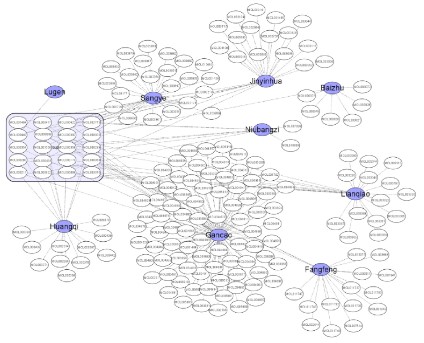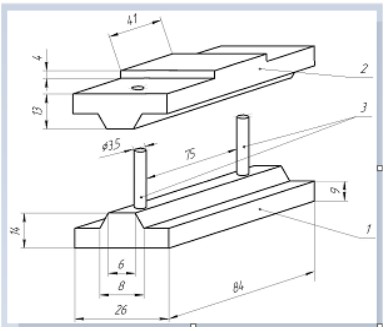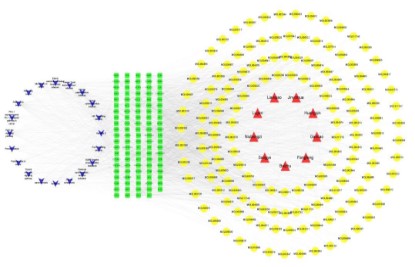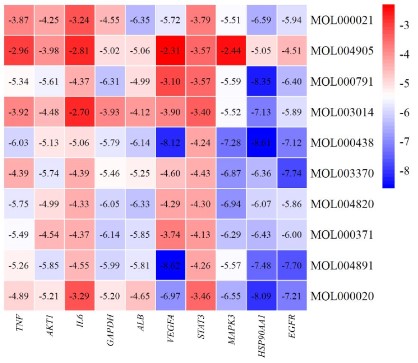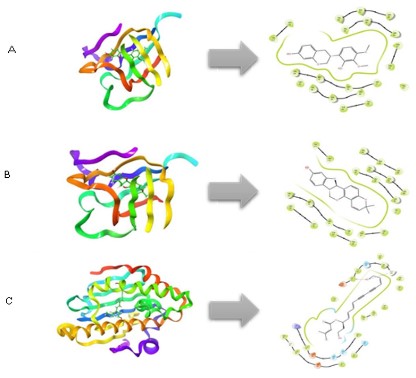Introduction
The novel coronavirus pneumonia (COVID-19) outbreak at the
end of 2019 has continuously raged all around the world. Existing
research has suggested that Severe Acute Respiratory Syndrome
Coronavirus 2 (SARS-CoV-2) comprises single stranded positive
strand RNA 1, which is easy to invade the respiratory and digestive
systems of the body, thus causing several disease symptoms. More
asymptomatic infections were identified with the deepening of
research and the further optimization of detection technology
2. As of 2022, over 6 million people have died worldwide. SARS-COV-2 has exerted significant adverse effects on social and
economic development and the lives of residents due to its high
infectivity and pathogenicity.
COVID-19 falls into the category of “Yibing” in TCM, also
known as “plague”3, and TCM shows great advantages in treating
this disease4-7. Due to the continuous spread of the pandemic,
Shandong Province officially released the TCM compound,
“Fangyifang”, for the prevention of COVID-19 in March 2022
(https://sd.ifeng.com/c/8ENYvTJXsKw), which has played a major
role in preventing COVID-19. Fangyifang comprises Hedysarum
Multijugum Maxim 12 g, Atractylodes Macrocephala Koidz 9 g,
Saposhnikoviae Radix 6 g, Lonicerae Japonicae Flos 9 g, Forsythiae
Fructus 9 g, Mori Follum 6 g, Fructus Arctii 6 g, Phragmitis
Rhizoma 9 g, as well as licorice 3 g. It is capable of nourishing
qi and strengthening the surface, clearing heat, and detoxifying
poisonous substances. In this study, the mechanism of action of
“FangyiFang” in the intervention of COVID-19 was explored using
network pharmacology technology to provide theoretical support
for its social promotion.
Methods and tools
Characteristics of “FangyiFang”
The four properties, five tastes, channel tropism, and main effects of the drug are obtained by consulting the pharmacopoeia
of TCM (http://yaobw.cn/yaobw/)
Collection of components and component targets of herbal
medicines in “FangyiFang”
The active ingredients of Hedysarum Multijugum Maxim,
Atractylodes Macrocephala Koidz, Saposhnikoviae Radix, LoniceraeJaponicae Flos, Forsythiae Fructus, Mori Follum, Fructus Arctii, Phragmitis Rhizoma and licorice were searched through the
TCMSP database (https://old.tcmsp-e.com/tcmsp.php), with the
oral availability (OB)≥30% and drug-likeness properties (DL) ≥ 0.18
as the screening conditions [8]. Subsequently, Pubchem (https://
pubchem.ncbi.nlm.nih.gov) was adopted to search the corresponding “Canonical SMILES” of each component, or use another
method—download the structural formula of the component
compound from the TCMSP database. Next, the structural formula was imported into open Babel GUI software to obtain “Canonical SMILES”. Lastly, the target was predicted on the platform
of “Swiss Target Prediction”, input the “Canonical SMILES”, set the
species as “Homo sapiens”, the Excel format was downloaded,
and the target information with possibility=0 was deleted in the
Excel table.
Obtaining disease targets
With “new coronavirus pneumonia” 9 as the keyword, the targets related to COVID19 were collected through the Genecard database (https://www.genecards.org) search.
Obtain the intersection target of “herbal ingredients-diseases”
The “TCM ingredient-disease” intersection target was obtained intuitively. The WENN Y2.1 online tool (https://bioinfogp.
cnb.csic.es/tools/venny/), input disease targets and d rug targets
were employed, respectively, and Venn diagrams were drawn to
obtain disease-component intersection targets.
Protein-Protein Interaction network (PPI) network construction and network pharmacology analysis
To more effectively observe the interconnection between the
intersection targets and show the vital targets that work. The acquired intersection targets were submitted to the STRING11.0
database [10] (https://string-db.org), the biological species was
set to “Homo sapiens”, the rest of the options was set as default
settings, and unconnected targets were removed. Lastly, the TSV
format file was downloaded and imported into Cytoscape 3.7.1
software for visual network topology analysis.
Bioinformatics-GO and KEGG enrichment analysis
Input intersection targets into “Metascape” platform (https://
metascape.org/gp/index). Subsequently, its main biological process (BP), molecular function (MF), cellular component (CC) and
KEGG pathway were analyzed. Lastly, the main BP, MF, CC were
integrated, and metabolic pathway results were plotted into the
bubble charts for visualization.
Construct an “active ingredient-target-KEGG pathway” network to screen the key active ingredients of “FangyiFang”
TCM exhibits the characteristics of multiple components acting
on multiple targets, which is in part to screen out the key active
ingredients in this herbal compound. The top 20 pathways and
the targets on the pathway were selected, and the “active ingredient-target-KEGG pathway” network diagram was constructed by
CytoScape 3.7.2 software. Next, the key active ingredients that
play a role were screened out according to the network topology
parameters Degree, Betweenness and Closeness.
Molecular docking of active ingredients and vital targets
To better demonstrate the binding ability of the drug and the
target, the active in gredients and vital targets were screened from
the above steps for molecular docking verification. First, the crystal structure of the core target (receptor) was downloaded from
the PDB database [11,12], and the structural formula of the active
ingredient of the small molecule (ligand) were downloaded from
the TCMSP database. Next, molecular docking experiments were performed by importing into “Schrödinger Maestro” software
[13]. Before docking, the ligands were processed by the “LIGPEP”
program. If the downloaded receptor has a ligand structure, molecular docking was performed at the receptor site. If there is no
ligand structure, the “Binding Site Detect” program will be select
ted to predict the binding site. Finally, the two were docked by the
“Receptor Grid Generation” procedure, and the binding energy
was recorded.
Table 1: Characteristics and main efficacy of traditional Chinese medicine of “FangyiFang”.
| Drug name |
Four properties and five tastes |
Meridians |
Main efficacy |
| Hedysarum Mul tijugum Maxim |
Lukewarm, sweet |
Lung, spleen |
Invigorate Qi and Yang, strength hen the exterior and stop
sweating, etc. |
| Atractylodes M acrocephala Koidz |
Warm, bitter and sweet |
Spleen, Stomach |
Strengthening the spleen and replenishing qi, etc. |
| Saposhnikoviae Radix |
lukewarm, pungent and sweet |
Bladder, Liver and Spleen |
Expelling wind to relieve superficies, removing dampness to
relieve pain |
| Lonicerae Japo nicae Flos |
cold, sweet |
lung, heart and stomach |
Clearing away heat and toxin, evacuating wind heat |
| Forsythiae Fructus |
micro cold, bitter |
Lung, heart an d Small Intestine |
Heat clearing and detoxification, detumescence and
dissipation, and evacuation of wind heat |
| Mori Follum |
Cold, bitter and sweet |
Lung and liver |
Evacuate wind heat, clear lung and moisten dryness |
| Fructus Arctii |
Cold, bitter and pungent, |
Lung and stomach |
Evacuate wind-heat, detoxify etc. |
| Phragmitis Rhizoma |
CCold and sweet |
Lung and stomach |
Clearing heat and purging fire, generating saliva and quenching
thirst, etc. |
| licorice |
Peaceful, sweet |
Heart, lung, spleen and stomach |
Invigorate the spleen and stomach, etc. |
Results
Drug characteristics in “FangyiFang”
The characteristics and main effects of nine Chinese herbal
medicines were obtained through the review of the Chinese pharmacopoeia. The characteristics of herbal medicines contain four
properties (including cold, cool, warm, and hot), five tastes (including sour, bitter, sweet, pungent, and salty) and meridians to
which they belong, and the above characteristics determine their
efficacy and clinical application, as listed in table 1.
Herbal component targets and disease targets
Through the TCMSP database, 20 components of Hedysarum
Multijugum Maxim, 7 components of Atractylodes Macrocephala
Koidz, 17 components of Saposhnikoviae Radix, 23 components
of LoniceraeJaponicae Flos, 23 components of Forsythiae Fructus,
29 components of Mori Follum, 8 components of Fructus Arctii,
11 components of Phragmitis Rhizoma and 92 components of
licorice (Figure 2) were obtained, including 4 components that did
not predict the target (MOL003111, MOL011753, MOL011730,
MOL004829). After summarizing and removing duplicate drug
targets, 1004 drug targets were obtained (Table 2). A total of 1039
disease targets were obtained. Drugs and diseases share 176 targets (Figure 3).
Table 2: The number of ingredients and the target number of in-
gredients in each herb.
| Chinese name |
English latin name |
Number active ingredients |
Number of targets |
| 黄芪 |
Hedysarum Huangqi Multijugum Maxim |
20 |
1149 |
| 白术 |
Atractylodes
Baizhu
Macrocephala Koidz |
7 |
400 |
| 防风 |
Saposhnikoviae Radix Fangfeng |
17 |
913 |
| 金银花 |
Lonicerae
Japonicae Flos |
Jinyinhua |
23 |
1321 |
连翘 |
Forsythiae Fructus |
Lianqiao |
23 |
11263 |
桑叶 |
Mori Follum |
Sangye |
29 |
1503 |
牛蒡子 |
Fructus Arctii |
Niubangzi |
8 |
341 |
芦根 |
Phragmitis Rhizoma |
Lugen |
1 |
42 |
甘草 |
licorice |
Gancao |
92 |
3293 |
PPI Network
The 176 intersection targets entered STRINGT database to obtain the initial PPI network (Figure 4a), in which there were four
independent targets (MARK1, MGAT2, ADCK4 and SLC6A15). After
the four free targets were removed, the initial network was down
loaded and imported into Cytoscape 3.7.1 software to optimize
the visual view, such that a PPI network graph with 172 nodes and
2729 edges (Figure 4b) was obtained. Th e top 10 (≥86) targets in
the PPI network were selected as the vital targets (Table 3).
Table 3: Top ten gene targets in PPI network and pharmacological
parameters of gene target network.
| Gene name |
Degree |
Betweenness centrality |
Closeness centrality |
| TNF |
123 |
0.086296115 |
0.780821918 |
| AKT1 |
123 |
0.088332264 |
0.780821918 |
| IL6 |
112 |
0.063460802 |
0.743478261 |
| GAPDH |
111 |
0.045357392 |
0.737068966 |
| ALB |
105 |
0.053842489 |
0.721518987 |
| VEGFA |
92 |
0.021565811 |
0.678571429 |
| STAT3 |
88 |
0.017621213 |
0.66023166 |
| MAPK3 |
87 |
0.022613706 |
0.66536965 |
| HSP90AA1 |
87 |
0.024370702 |
0.657692308 |
| EGFR |
86 |
0.026471547 |
0.662790698 |
Enrichment of Go and KEGG pathways at intersection targets
GO enrichment analysis was conducted on 176 intersection
targets. A total of 1902 biological process entries (BP), 184 molecular function entries (MF) and 122 cellular composition entries
(CC) were obtained. BP primarily comprises protein phosphorylation, cellular response to nitrogen compound, inflammatory
response, cellular response to organonitrogen compound, cell
activation, response to hormone, positive regulation of cytokine
production, positive regulation of response to external stimulus,
positive regulation of cell migration and positive regulation of cell
motility, etc. MF involves kinase activity, phosphotransferase activity, alcohol group as acceptor, protein kinase activity, protein
serine/threonine/tyrosine kinase activity, kinase binding, protein
serine/threonine kinase activity, protein kinase binding, protein
serine kinase activity, lipid binding and protein domain specific
binding, etc. CC covers side of membrane, external side of plasma
membrane, membrane raft, membrane, microdomain, peripheral region of cytoplasm, lytic vacuole, lysosome, vesicle lumen,
cytoplasmic vesicle lumen and nuclear envelope, etc. The top 10
were selected for drawing respectively (Figure 5). Furthermore, it
is speculated that the “FangyiFang” to prevent COVID-19 may be
correlated with the above biological processes.
Likewise, 176 intersection targets were subjected to KEGG enrichment analysis. A tot al of 198 pathways were obtained, and
the top 20 signaling pathways were selected to make KEGG bubble
charts for view analysis (Figure 6). The results suggest that besid
es the cancer pathway ranking first, the above pathways are more
correlated with viral infection (e.g., human tumor virus infection,
Kaposi's sarcoma-associated herpes virus infection, hepatitis B,
human T-cell leukemia virus 1 infection, and Human cytomegal
ovirus infection), of which the COVID-19 pathway ranks 10th.
Table 4: Network node characteristic parameters of active ingredients for preventing COVID-19 in “FangyiFang”.
| MOL |
Name |
Degree |
Betweenness |
Closeness |
Source |
| MOL000021 |
14-acetyl-12senecioyl-2E,8 E,10E-atractyl entriol |
27 |
0.013471 |
0.433846 |
Atractylodes Mac rocephala Koidz |
| MOL004905 |
3,22-Dihydrox y-11-oxo-delt a (12)-oleane ne-27-alphamethoxycarbo nyl-29-oic acid |
26 |
0.017478 |
0.444795 |
licorice |
| MOL000791 |
bicuculline |
26 |
0.008636 |
0.435185 |
Forsythiae Fructus |
| MOL003014 |
secologanic di butylacetal_qt |
25 |
0.011171 |
0.431193 |
Lonicerae Japoni cae Flos |
| MOL000438 |
(3R)-3-(2-hyd roxy-3,4-dime thoxyphenyl) chroman-7-ol |
24 |
0.005712 |
0.420896 |
Hedysarum Multi jugum Maxim |
| MOL003370 |
OnjixanthoneI |
24 |
0.00682 |
0.439252 |
Forsythiae Fructus |
| MOL004820 |
Kanzonols W |
23 |
0.012377 |
0.429878 |
licorice |
| MOL000371 |
3,9-di-O-methylnissolin |
22 |
0.008715 |
0.414706 |
Hedysarum Multi jugum Maxim |
| MOL004891 |
shinpterocarpin |
22 |
0.005478 |
0.435185 |
licorice |
| MOL000020 |
12-senecioyl2E,8E,10E-atra ctylentriol |
22 |
0.010159 |
0.433846 |
Atractylodes Mac rocephala Koidz |
Construction of “drug ingredient-target-pathway” network
and screening of active ingredients in “FangyiFang
We selected the top 20 KEGG pathways and reversely screened
the active ingredients in the “FangyiFang” for the prevention of
COVID-19 according to the targets on the pathway. The Cytoscape
3.8.2 software view shows that the network has 283 nodes and
2325 edges (Figure 7), which are sorted according to the numerical values of Degree, Betweenness, and Closeness to obtain active
components (Table 2).
Molecular docking results of active ingredients and vital
target
We conduct molecular docking between the active ingredients
and vital targets of the “FangyiFang”, and calculate the binding
energy between the two to predict their binding activity. It is
generally believed that the binding energy < 0 kcal·mol-1 indicates
that the two molecules can spontaneously bind, and the binding
energy <-5.0 kcal·mol-1 indicates a good binding effect.
As depicted in Figure 8, all molecular docking results in this
experiment were less than 0 kcal·mol-1, and most of the 100
docking results had binding energies less than -5.0 kcal·mol1,
suggesting that some active ingredients and vital targets can be
well combined. Furthermore, it indicates the scientific nature
of the “FangyiFang” to prevent COVID-19. According to the
molecular docking value, the top three molecular docking views
are displayed (Figure 9).
Discussion
The COVID-19 pandemic has raged for over two years, and
there have been mutations (e.g., Omicron and delta) recently
[14]. Although COVID-19 is a class B infectious disease, it is still
prevented and controlled as a Class A infectious disease in China15. In this study, the mechanism of action of “FangyiFang” in
the intervention of COVID-19 was explored using network pharmacology and molecular docking technology.
Prescription analysis of “FangyiFang”
In accordance with existing literature reports, patients with
COVID-19 mostly had respiratory symptoms (e.g., fever and
cough), and some also developed gastrointestinal symptoms (e.g.,
anorexia, nausea and vomiting, as well as diarrhea). More asymptomatic infections have been found over the past few years. The
pathogenesis theory of TCM suggests that “the righteousness
is in the body, and the evil cannot do it” [16,17], and “the lack
of the righteousness is the fundamental cause of the disease of
the body”. Most of the herbs in the “FangyiFang” are “sweet and
warm” in four properties and five tastes (e.g., Hedysarum Multijugum Maxim). The above are designed to nourish the body's
righteousness. Second are herbs with “bitter and cold” in four
properties and five tastes (e.g., Forsythiae Fructus and Lonicerae
Japonicae Flos), which are designed to clear away heat and detoxify poisonous substances since patients with COVID-19 have
fever. Furthermore, dampness is the critical factor causing the
pathogenesis of COVID-19 18, so Phragmitis Rhizoma is given to
treat dampness and heat toxicity.
Vital targets
SARS-CoV-2 invades the adjacent deep lung stroma and binds
with ACE2 on the alveoli, thus inducing the activation of inflammatory cytokines and causing damage to the epithelial cells of
the alveolar wall. The result achieved under CT microscope has i
ndicated that the COVID-19 patient's lungs show glassy shadows
[19].
In the PPI network of this study, TNF, AKT1, IL-6, GAPDH, ALB,
VEGFA, STAT3, MA PK3, HSP90aa1 and EGFR were selected as the
vital targets to take effect in accordance with the topological parameter values of degree and other networks. It is speculated that
the above targets may be the vital target genes for the “FangyiFang” to prevent COVID-19. STAT3 takes on a critical significance
in regulating the expression of inflammatory factors 20, which can
be activated by different cytokines and growth factor s (e.g., IL-6
and TNF). IL-6 is an endogenous pyrogen of which the function
is correlated with various inflammation related diseases and can
cause high fever in people with autoimmune diseases or virus infection. Existing research has suggested that 21 C OVID-19 can be
effectively prevented by down-regulating the expression of IL-6 in
serum. SARS-CoV-2 can induce human macrophages and dendritic
cells to release proinflammatory cytokines (e.g., TNF- α). Furthermore, too much TNF can result in lung tissue damage.
AKT1 is one of the three members of Akt serine threonine protein kinase family. It is capable of regulating numerous processes
(e.g., metabolism, proliferation, cell survival, growth, and angiogenesis). In addition, AKT1 can regulate the development and
function of innate immune cells (neutrophils, macrophages, and
dendritic cells) [22]. Forced AKT1 signal transduction can lead to the proliferation of airway smooth muscle and the occurrence of
asthma [23,24]. AKT1 is confirmed as a potential target for COVID-19 treatment and prevention [25].
GAPDH exhibits the activities of glyceraldehyde-3-phosphate
dehydrogenase and nitrosylase, which play a role in glycolysis
and nuclear function respectively. Recent studies have shown
that inhibition of GAPDH in individuals with deteriorating cellular innate immune response (e.g., the elderly) may be beneficial
to treat COVID-19 and other viral diseases [26]. ALB is capable
of regulating plasma colloidal osmotic pressure, and it takes on
a critical significance in maintaining human nutrition as a carrier
protein of various endogenous molecules (e.g., hormones, fatty
acids, and metabolites) and exogenous drugs. Recent studies have
suggested that elderly patients with COVID-19 have a significantly
high prevalence of malnutrition, and malnutrition will increase
the mortality of SARS-CoV-2 [27].
Go enrichment and KEGG pathway analysis
In this study, GO enrichment analysis of 176 intersecting targets was conducted on the Metascape platform. The results suggest that the intersecting targets are primarily mainly enriched in
biological processes (e.g., inflammation, protein phosphorylation,
positive regulation of cell migration, and positive regulation of cell
movement). Molecular function items include the activities of a
series of enzymes (e.g., phosphoprotein serine/threonine/tyrosine kinases), and most of the above enzymes are correlated with
protein phosphorylation. Protein phosphorylation is one of the
most investigated and well-understood protein post-translational
modifications, and it plays a role in almost all biological processes
[28]. It is speculated that “FangyiFang” may affect the regulation
of inflammatory factors by affecting the process of protein phosphorylation, thus inhibiting the “cytokine storm” and avoiding
the occurrence of COVID-19. The result of KEGG pathway analysis
suggests that most of the pathways are correlated with viral infect
ion, among which the COVID-19 pathway ranks 10th.
In brief, based on the concept of “prevention treatment of disease” in TCM, “FangyiFang” acts on the main pathways of human
papillomavirus, Kaposi’s sarcoma associated herpesvirus, cytomegalovirus, and COVID-19 through vital targets (e.g., TNF, AKT1,
I L6, and STAT3), inhibits the occurrence of inflammatory reaction
by affecting the level of protein phosphorylation, and plays a certain role in COVID-19 prevention.
In this study, we confirmed the multi-component, multitarget, and multi-channel mechanism of the TCM compound
“FangyiFang” through network pharmacology and molecular
docking technology. For reverse screening of active components
through the main channels, 14-acetyl-12-senecioyl-2E,8E,10E-atractylentriol,3,22-Dihydroxy-11-oxo-delta (12)-oleanene-27-alpha-methoxycarbonyl-29-oic acid, bicuculline and other active
ingredients (Table 4). It is necessary to conduct in-depth experimental verification for the specific inhibitory effect of the above
active ingredients on SARS-CoV-2.
Declarations
Data availability: Data will be made available on request.
Funding sources: This study was supported by the Jinan“20
Items in Universities” Funded Project (NO. 2020GXRC002).
Author contributions: Wu Tao is responsible for the overall
writing and typesetting design of the paper. Qu mengrou and Chen
XianMei are responsible for querying and collecting the target s
of Chinese herbal ingredients and sorting them out. Yu Xufeng
provided very valuable opinions for this study and also provided
technical support for molecular docking. Professors Qiao Mingqi
and Wang Jieqiong checked the overall design of the study, and
revised and reviewed the manuscript.
Declaration of competing interest: The authors declare no
conflicts of interest.
References
- Zumla A, Chan JF, Azhar EI, Hui DSC, Yuen KY,et al. Coronaviruses
- drug discovery and therapeutic options. Nat Rev Drug Discov.
2016; 15: 327-347.
- Jiang JJ, Gao C, Feng FJ. Research progress on detection methods
of the asymptomatic COVID-19 infected persons. Journal of Hainan Medical University. 2022; 28:161-165.
- Yu XM, Chen L, Zhou LP: Analysis of TCM understanding and treatment experience of novel coronavirus pneumonia. The Journal of
Medical Theory and Practice. 2021; 34: 3858-3859.
- Hu J, Xiao Y, Shao SA, Gu R, Shi QM, et al. Construction and application of carbohydrate microarrays to detect foodborne bacteria.
Chin J Nat Med. 2020; 18: 219-225.
- Li Y, Liu X, Guo L, Li J, Zhong D, et al. Traditional Chinese herbal
medicine for treating novel coronavirus (COVID-19) pneumonia:
protocol for a systematic review and meta-analysis. Syst Rev. 2020;
9: 75.
- Luo E, Zhang D, Luo H, Liu B, Zhao K, et al. Treatment efficacy analysis of traditional Chinese medicine for novel coronavirus pneumonia (COVID-19): an empirical study from Wuhan, Hubei Province,
China. Chin Med. 2020; 15: 34.
- Runfeng L, Yunlong H, Jicheng H, Weiqi P, Qinhai M, et al. Lianhuaqingwen exerts anti-viral and antiinflammatory activity against
novel coronavirus (SARS-CoV-2). Pharmacol Res. 2020; 156:
104761.
- Li X, Lin H, Wang Q, Cui L, Luo H, et al. Chemical composition and
pharmacological mechanism of shenfu decoction in the treatment
of novel coronavirus pneumonia (COVID-19). Drug Dev Ind Pharm.
2020; 46: 1947-1959.
- Pinero J, Sauch J, Sanz F, Furlong LI. The DisGeNET cytoscape app:
Exploring and visualizing disease genomics data. Comput Struct
Biotechnol J. 2021; 19: 2960-2967.
- Szklarczyk D, Gable AL, Nastou KC, Lyon D, Kirsch R, et al. Correction to ‘The STRING database in 2021: customizable protein-protein networks, and functional characterization of user-uploaded
gene/measurement sets’. Nucleic Acids Res. 2021; 49: 10800.
- Liu XY, Wang XL, Qiu MC, Ye YJ, Wang F, et al. Exploring the Protective Effect and Mechanism of Buddlejae Flos on Sodium Selenite-Induced Cataract in Rats by Network Pharmacology, Molecular
Docking, and Experimental Validation. Evid Based Complement
Alternat Med. 2022; 7776403.
- Sussman JL, Lin D, Jiang J, Manning NO, Prilusky J, et al. Protein
Data Bank (PDB): database of three-dimensional structural information of biological macromolecules. Acta Crystallogr D Biol Crystallogr. 1998; 54: 1078-1084.
- Chikhale RV, Sinha SK, Khanal P, Gurav NS, Ayyanar M, et al. Computational and network pharmacology studies of Phyllanthus emblica to tackle SARS-CoV-2. Phytomed Plus. 2021; 1: 100095.
- Li J, Zhang Y, Jiang L, Cheng H, Li J, et al. Similar aerosol emission
rates and viral loads in upper respiratory tracts for COVID-19 patients with Delta and Omicron variant infection. Virol Sin. 2022; 37:
762-764.
- Chen H, Ba Y, Zhang W. Strategy and transport practice of COVID-19
prevention and control system in prehospital emergency. Strategy
and transport practice of COVID-19 prevention and control system
in prehospital emergency. China Journal of Emergency Resuscitation and Disaster Medicine. 2021; 16: 866-870.
- Chen HT, Jiang X, Luo SJ. Prevention and Treatment of Novel Virus
Pneumonia Based on the Theory of “vital qi in the body, pathogenic qi can’t attack”. Asia-Pacific Traditional Medicine. 2020; 16:
4-6.
- Xu XY, Liu FM. Exploration on Traditional Chinese Medicinal Prevention of the Novel Coronavirus Pneumonia COVID-19 Under the
Theory of “Healthy qi was preserved inside, pathogenic factor cannot intrude”. Journal of Hubei College of Traditional Chinese Medicine. 2020; 22: 9-11.
- Ma PF, Yu ZM. Discussion on Etiology Pathogenesis and Treatment
of Sequelae of Sensory and Regulatory Impairment of Coronavirus Disease 2019 from Perspective of Pathogenic Dampness.
Shandong Journal of Traditional Chinese Medicine. 2022; 41: 385-388+407.
- Jiang F, Deng L, Zhang L. Review of the Clinical Characteristics of
Coronavirus Disease 2019 (COVID-19). J Gen Intern Med. 2020; 35:
1545-1549.
- Hillmer EJ, Zhang H, Li HS. STAT3 signaling in immunity. Cytokine
Growth Factor Rev. 2016; 31: 1-15.
- Coomes EA, Haghbayan H. Interleukin-6 in Covid-19: A systematic
review and meta-analysis. Rev Med Virol. 2020; 30: 1-9.
- Zhang Y, Wang X, Yang H. Kinase AKT controls innate immune cell
development and function. Immunology. 2013; 140: 143-152.
- Ebina M, Takahashi T, Chiba T. Cellular hypertrophy and hyperplasia of airway smooth muscles underlying bronchial asthma. A 3-D
morphometric study. Am Rev Respir Dis. 1993; 148: 720-726.
- Ma L, Brown M, Kogut P. Akt activation induces hypertrophy without contractile phenotypic maturation in airway smooth muscle.
Am J Physiol Lung Cell Mol Physiol. 2011; 300: L701-709.
- Xia QD, Xun Y, Lu JL. Network pharmacology and molecular docking analyses on Lianhua Qingwen capsule indicate Akt1 is a potential target to treat and prevent COVID-19. Cell Prolif. 2020; 53:
e12949.
- Ebrahimi KH, Gilbert-Jaramillo J, James WS. Interferon-stimulated
gene products as regulators of central carbon metabolism. FEBS J.
2021; 288: 3715-3726.
- Rotondi M, Coperchini F, Ricci G. Detection of SARS-COV-2 receptor ACE-2 mRNA in thyroid cells: a clue for COVID-19-related sub-acute thyroiditis. J Endocrinol Invest. 2021; 44: 1085-1090.
- Ubersax JA, Ferrell JE. Mechanisms of specificity in protein phosphorylation. Nat Rev Mol Cell Biol. 2007; 8: 530-541.


